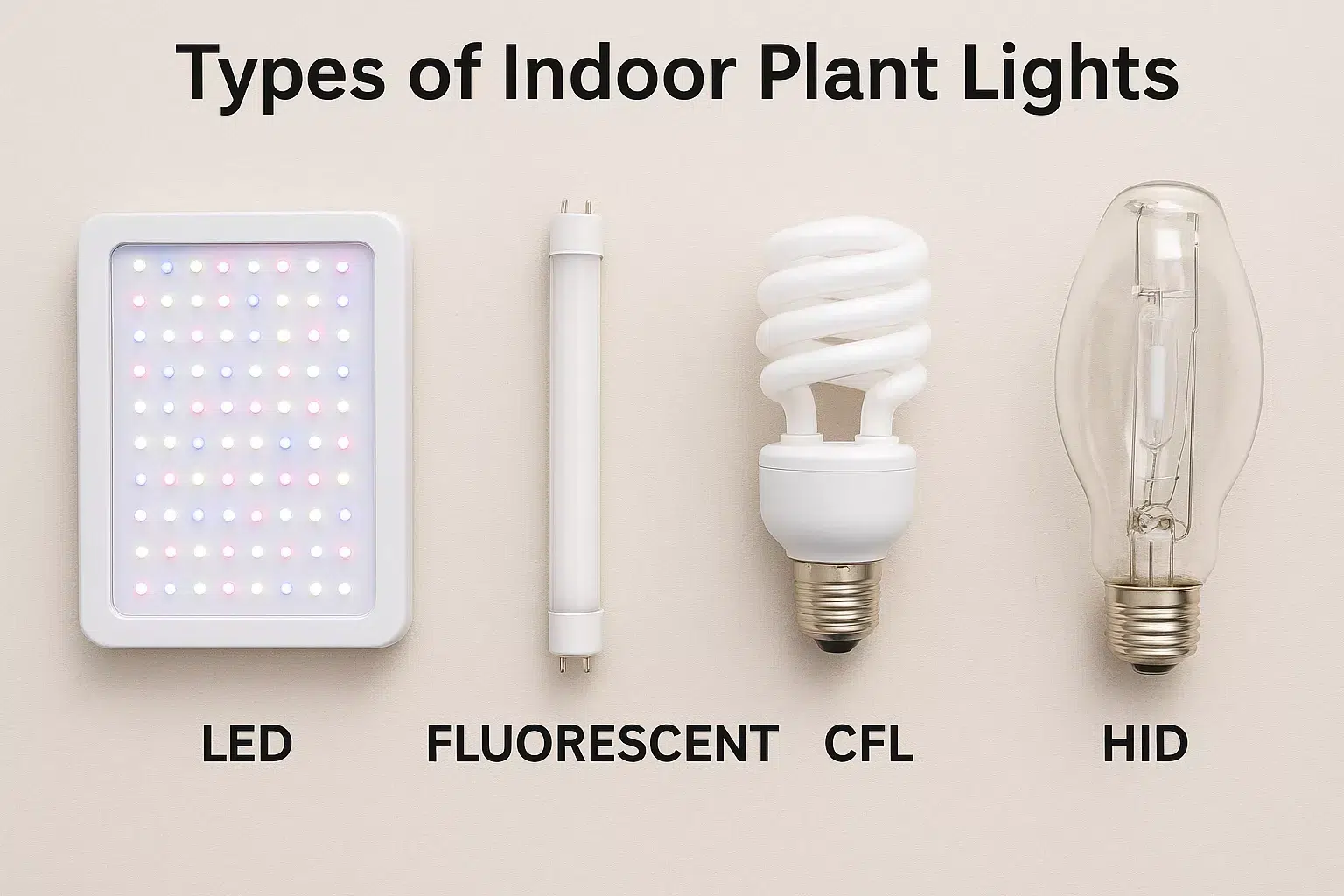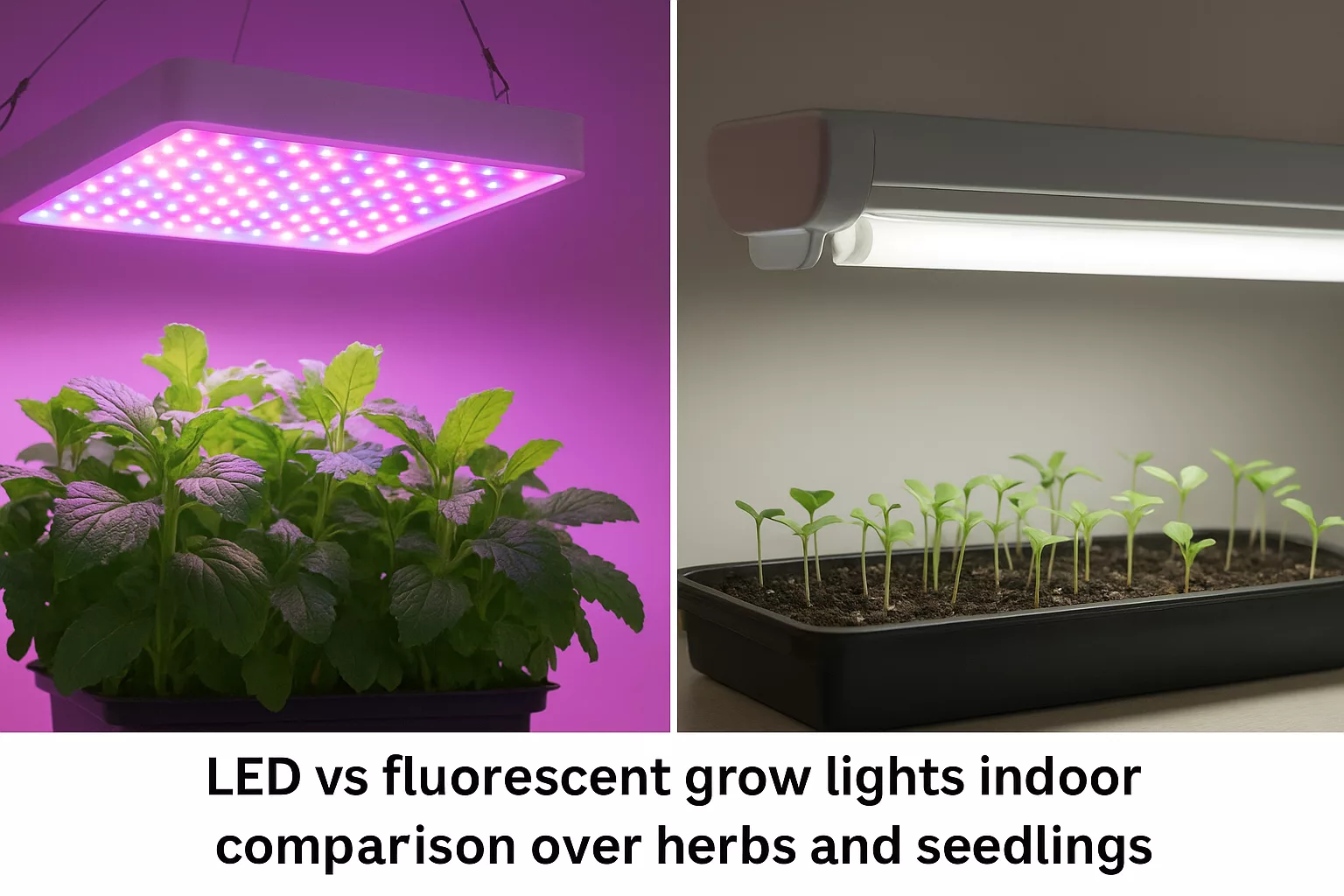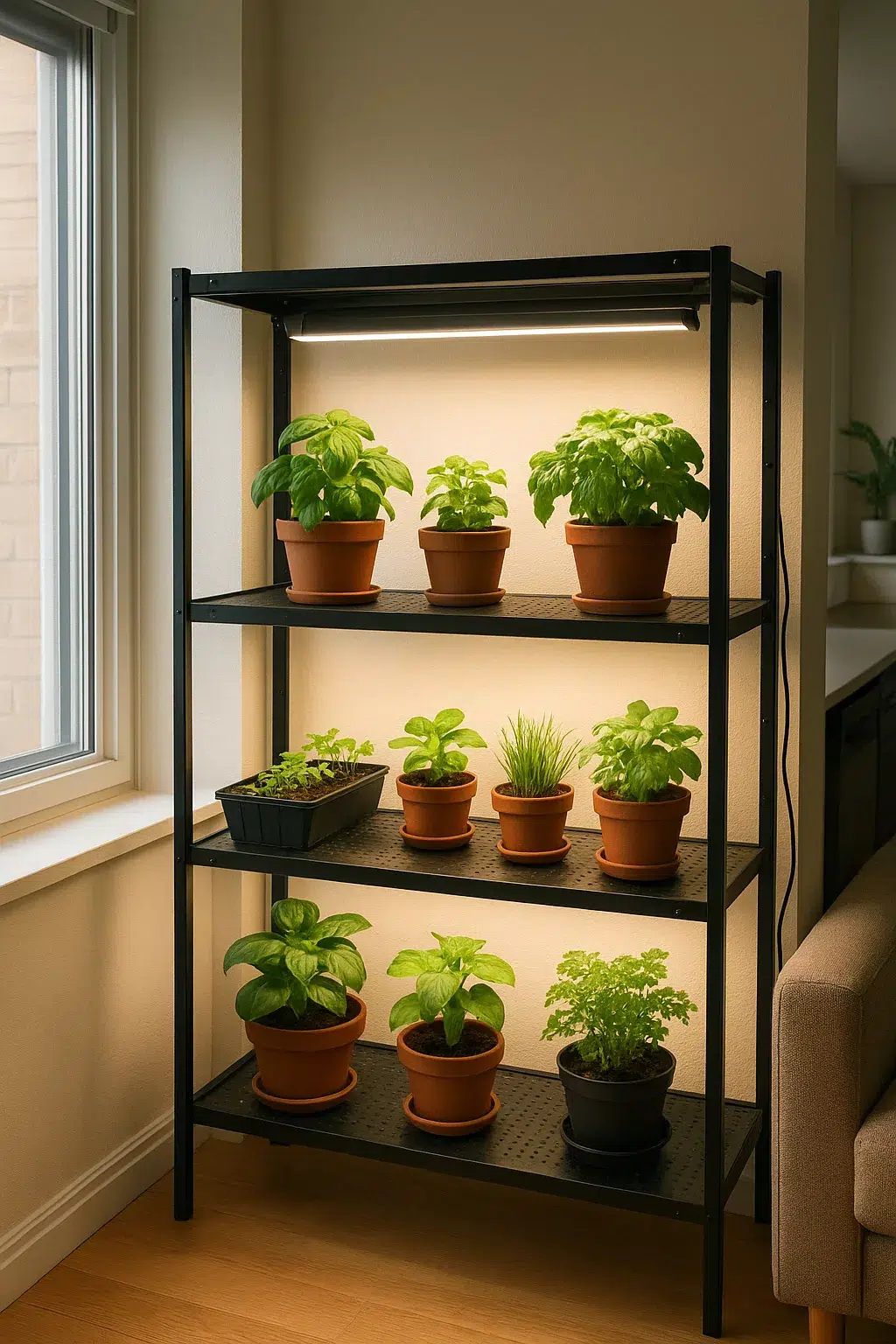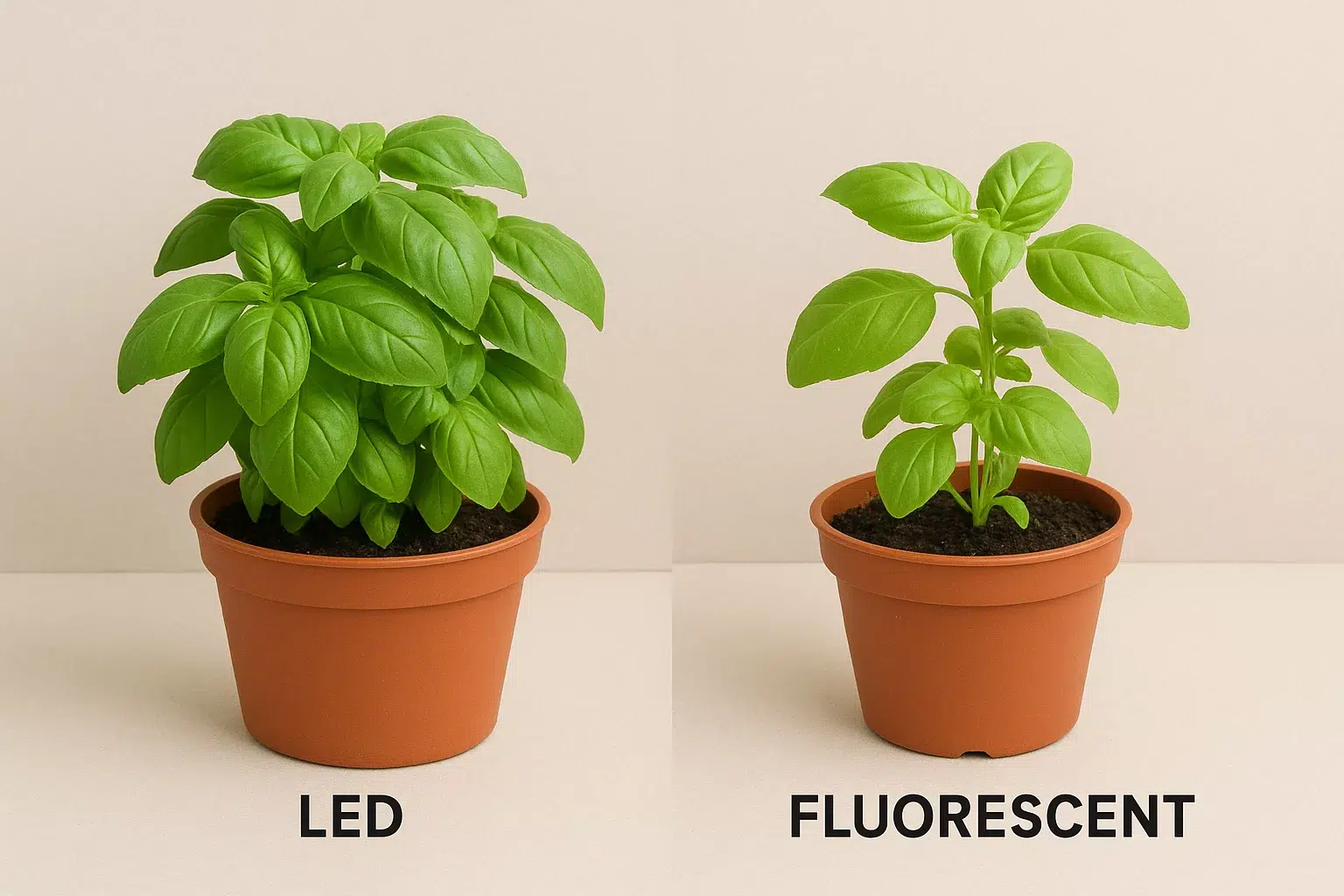Introduction
LED vs fluorescent grow lights indoor is one of the most common debates among home gardeners who want to grow healthy plants inside. Choosing the right artificial light can make or break your indoor garden. Whether you live in an apartment without much sunlight, or you’re simply extending the growing season, the decision between LED and fluorescent lighting is crucial. In this guide, I’ll share hands-on experience, highlight the pros and cons grow lights bring, and help you decide which system fits your indoor gardening needs.
Why Grow Lights Matter for Indoor Gardening
Indoor plants rely on artificial lighting to mimic the natural spectrum of the sun. Without the right balance, you may end up with leggy stems, weak leaves, or poor flowering.
Types of Indoor Plant Lights

There are several categories of grow lights available today:
- LED (Light Emitting Diode) – Modern, efficient, and customizable.
- Fluorescent (T5, T8, CFL) – Affordable and widely used in small setups.
- High-Intensity Discharge (HID) – Powerful but less common in homes due to heat and energy usage.
- Halogen and Incandescent – Outdated, inefficient, and not recommended.
This article will focus primarily on LED and fluorescent grow lights since they’re the most practical for homes, offices, and apartments.
LED vs Fluorescent Grow Lights Indoor: Key Differences

1. Energy Efficiency
- LEDs consume up to 50% less electricity compared to fluorescents.
- They convert more energy into usable light instead of heat, reducing wasted power.
2. Light Spectrum
- LEDs can be tuned to provide a full spectrum (red, blue, UV, IR), which closely mimics sunlight.
- Fluorescents usually emit a cooler white or blue-heavy spectrum, better for seedlings but less ideal for flowering stages.
3. Heat Output
- LEDs stay cooler, making them safe for small grow tents or apartments.
- Fluorescents emit moderate heat but can still dry out plants if placed too close.
4. Lifespan
- LEDs: 50,000–100,000 hours on average.
- Fluorescents: 10,000–20,000 hours.
5. Cost
- Fluorescents are cheaper upfront but cost more long-term due to replacements and higher energy bills.
- LEDs require a higher initial investment but save money over time.
Pros and Cons Grow Lights: LED vs Fluorescent
LED Grow Lights
Pros:
- Energy efficient.
- Long lifespan.
- Customizable light spectrum.
- Low heat emission.
- Great for advanced growers.
Cons:
- Higher upfront cost.
- Some cheap models provide poor light quality.
Fluorescent Grow Lights
Pros:
- Affordable initial price.
- Easy to find in local stores.
- Good for beginners.
- Effective for seedlings and leafy greens.
Cons:
- Shorter lifespan.
- Higher energy use.
- Less effective for flowering plants.
Choosing the Right Light for Your Plants
Different plants thrive under different light conditions. Here’s a quick breakdown:
- Leafy Greens (lettuce, spinach, herbs): Fluorescents are usually enough for these low-light-demand plants.
- Flowering Plants (orchids, peppers, tomatoes): LEDs provide the red spectrum necessary for strong blooms and fruiting.
- Succulents and Cacti: LEDs with strong intensity prevent stretching and maintain compact shapes.
- Tropical Houseplants (monstera, philodendron): Both LEDs and fluorescents work, but LEDs help simulate the natural day/night cycle more effectively.
Cost and Energy Considerations
Over a year of continuous use:
- A fluorescent T5 fixture (100W) may cost around $90–110 in electricity plus bulb replacements.
- A comparable LED fixture (60W) may only cost $40–50 in electricity with no replacements needed for years.
For larger indoor gardens, this difference quickly adds up, making LEDs the more cost-effective option in the long run.
Installation Tips: Setting Up Your Grow Lights

- Measure your grow space – Small herb gardens need compact fixtures; larger hydroponic systems may need multiple panels.
- Set the correct height – LEDs (12–24 inches above canopy), fluorescents (6–12 inches).
- Use timers – Plants need consistent cycles. Automating prevents overexposure.
- Add reflectors or white walls – Improves efficiency by bouncing light back onto the plants.
- Ensure ventilation – Even LEDs produce some heat; good airflow prevents mold and stress.
Practical Experiences from Indoor Gardeners

In my apartment setup, I tested a 150W LED panel against a traditional T5 fluorescent fixture. Here’s what I noticed:
- Seedlings under fluorescents grew quickly at first but became spindly after 4–5 weeks.
- LED-grown plants developed stronger stems and greener leaves, even with less watering because the lights didn’t dry out the soil as much.
- Electricity bills were lower with LEDs, saving around $10 per month in a small grow tent.
A colleague running a hydroponic system in his office also confirmed that LEDs provided more compact and bushy growth compared to fluorescents, which worked fine for lettuce but struggled with tomatoes.
Common Mistakes and How to Avoid Them
- Placing lights too far from plants – Both LEDs and fluorescents need to be positioned correctly:
- LEDs: 12–24 inches depending on wattage.
- Fluorescents: 6–12 inches for optimal coverage.
- Ignoring the spectrum – Using only cool white bulbs may stunt flowering. Always check spectrum coverage.
- Overheating small spaces – Fluorescents in tiny grow boxes can raise temperatures. Use fans or switch to LEDs.
- Buying cheap, low-quality LEDs – Not all LEDs are equal. Look for trusted brands with tested PPFD ratings.
Maintenance and Safety Tips
- Clean bulbs and panels monthly to avoid dust blocking light.
- Check for heat buildup regularly, especially in enclosed grow tents.
- Replace fluorescent bulbs every 12 months even if they still “work,” as their spectrum degrades.
- Avoid overwatering under strong LEDs, as cooler soil can hold moisture longer.
- Always use surge protectors to prevent electrical accidents.
Comparing Different Systems
Here’s a quick breakdown of popular grow light systems:
- T5 Fluorescent Fixtures: Best for herbs, lettuce, and seedlings. Affordable but short-lived.
- Compact Fluorescent Lamps (CFLs): Work well for hobby growers but lack intensity for larger plants.
- Full-Spectrum LEDs: Suitable for all growth stages, scalable from small pots to larger hydroponic systems.
- COB (Chip-on-Board) LEDs: Powerful and efficient, popular among advanced indoor gardeners.
For a detailed guide on LED options, check this review of the best LED grow lights for indoor plants in 2025.
Tips for Maximizing Your Grow Lights
- Use a timer to maintain a consistent grow light schedule for indoor plants.
- Rotate plants weekly for even exposure.
- Pair lighting with automatic watering systems to reduce daily maintenance.
- Keep reflective surfaces (like Mylar or white walls) around your grow area to maximize light efficiency.
- Adjust intensity as plants mature—seedlings need gentler light than fruiting plants.
FAQs
Which is better for beginners, LED or fluorescent?
Fluorescents are cheaper and easy to use, but LEDs provide better long-term value and plant health.
Can I use regular household LED bulbs as grow lights?
Not all LEDs are suitable. Household bulbs often lack the red/blue spectrum needed for plant growth.
How many hours of light do indoor plants need?
Most plants thrive with 12–16 hours of artificial light per day, depending on the species.
Do fluorescent lights still have a place in indoor gardening?
Yes, they are still effective for starting seeds, growing microgreens, or for gardeners on a tight budget.
Are LEDs safe to use in small apartments?
Absolutely. Their low heat output makes them ideal for compact indoor gardens.
Do I need different lights for seedlings and mature plants?
Not necessarily—full-spectrum LEDs cover all stages, but some growers prefer fluorescents for seedlings and LEDs for flowering.
What’s the main reason to switch from fluorescent to LED?
Long-term savings, stronger plant growth, and less maintenance.
Conclusion
Choosing between LED vs fluorescent grow lights indoor depends on your budget, goals, and plant types. Fluorescents are affordable and effective for beginners, but LEDs offer efficiency, versatility, and better results for serious indoor gardeners. Based on years of personal and community experience, LEDs are the long-term winner for most setups.
🌱 Ready to take your indoor garden to the next level? Start your indoor garden today with the right grow lights and watch your plants thrive year-round!
